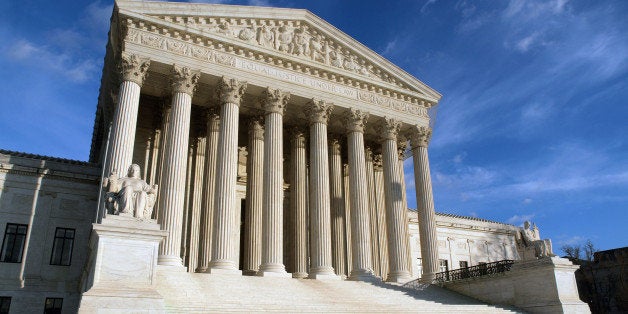
The Supreme Court heard oral argument earlier this month in two important cases from Texas, which are crucial to the principle of “one person-one vote” and the use of affirmative action in education across America. What happened during the arguments, including the stark divisions on the Court, illustrates again why Election Day 2016 will be Judgment Day for the Court and our rights and liberties. When voters go to the polls that day, they’ll choose the President who will select Supreme Court nominees beginning in 2017.
The first case, Evenwel v. Abbott, concerns what Supreme Court commentator Lyle Denniston called the “fundamental” question of how states draw state legislative and other voting district lines, which is crucial to fair representation. (Congressional districts are not at issue in this case.) Under the traditional “one-person one-vote” principle established by the Court in the 1960s, Texas and all other states have counted all people in the state as shown by census data, and then drawn district lines so that the number of people per representative is roughly equal. Right-wing advocates, however, claim in Evenwel that this is unconstitutional and that a more limited number of people - voters - should be the only ones counted. Whether they would measure citizens of voting age, registered voters, or actual voters is not clear. But any of the measures they discuss would significantly change districting decisions and effectively exclude children, legal immigrants who are not citizens, and those not registered to vote (who are disproportionately minority). As the Lawyers’ Committee for Civil Rights explained, the case “threatens to silence minorities and other groups” and make them “invisible in the eyes of state government.”
The four moderates on the Court - Justices Ginsburg, Breyer, Sotomayor, and Kagan - made clear their serious concerns with this approach, noting that elected representatives are supposed to represent all those in their districts, not just those who can or do vote. Comments from conservatives like Alito and Roberts suggested that they were receptive to the challengers’ arguments, however, leading Los Angeles Times writer David Savage to note the clear divisions and to suggest that the Court majority may well “order a significant shift” in redistricting as a result of the case.
Although the final result in any case is difficult to predict based on oral arguments, the case may once again come down to the vote of Justice Kennedy, who is often the swing vote. Kennedy’s comments suggested that he could well come down in the middle, leaning towards a ruling that would allow states to draw district lines based either on total population or on registered voters. Such an approach would itself be very troubling and would clearly lead to future decisions in this previously-settled area. But four justices on the current Court (Ginsburg, Scalia, Breyer, and Kennedy) will be over 80 during the term of the President that will begin in 2017, higher than the average retirement age for modern-era justices. Whether a future Supreme Court that reviews such decisions includes a right-wing or a moderate justice to replace current justices who may retire will be crucial.
In its last hearing before the holiday break, the Court considered Fisher v. University of Texas, a challenge to the University’s affirmative action plan concerning admissions. This is the second time the Court has agreed to hear the case, long after the challenger has been accepted at and graduated from another college. Although the Court had approved limited consideration of race as a factor in admissions in order to promote diversity in higher education in 2003, Justice O’Connor was the key to that decision. She is no longer on the Court, and has since been replaced by Justice Alito. Based on the oral arguments this month and prior writings, Alito is clearly one of the “four votes to end affirmative action in higher education” now on the Court, as Dahlia Lithwick has explained. The three moderates on the Court who heard the case (Justice Kagan recused herself because she was involved in it while in the Obama Justice Department) made clear that they disagreed.
The argument received more attention than usual because of Justice Scalia’s comment, relying on a friend-of-the-court brief filed with the Court, that some argue that “it does not benefit African-Americans” admitted through affirmative action to “get them into the University of Texas,” as “opposed to having them go to a less-advanced” or “slower-track school.” Regardless of the extent to which that comment reflected Scalia’s own views, the statement and the resultant controversy capture the high stakes in the case and the continued dispute over affirmative action.
As he often does in such closely divided cases, Justice Kennedy will likely determine the outcome. Assuming that he does not join with the more right-wing conservatives to completely end affirmative action, the two most likely results would be to strike down just the Texas plan or to send the case back to the lower courts so that the University could present more evidence, as Kennedy suggested at one point. Either of these two results would make future litigation that will reach the Court almost a certainty. Will a right-wing justice who would join the current four to completely ban affirmative action replace Kennedy, Ginsburg, or Breyer before the Court considers the issue again? Or will the next President replace a conservative justice who bends the law to favor the powerful with one who recognizes that the Constitution’s promise of liberty and equality make it a historically progressive document? The decision in Fisher is critical, but the answer to those questions may well determine even more definitively the future of affirmative action.
The issues at stake in these cases demonstrate the importance of the Supreme Court to the rights and interests of all of us. And the close divisions on the Court on these issues and the fact that they may well return to the Court, coupled with the fact that four justices will be over 80 in the next President’s first term, show the significance of the 2016 election on the future of the Court - and why November 8, 2016 truly will be Judgment Day. Apart from other issues in the upcoming election, the statements of Democratic and Republic candidates have made clear that they regard this issue as very important, and that the future direction of the Court will largely depend on which of them will become our next president.
